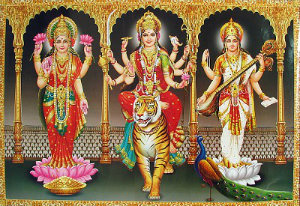Summary | Excerpt | Reading Guide | Discuss | Reviews | Beyond the Book | Read-Alikes | Genres & Themes | Author Bio

This article relates to The Opposite of Everyone
The Opposite of Everyone is peppered with elements from Hinduism, most prominently with references to the goddess Kali who is widely revered among Hindus for her ability to quell chaos during dark times (read 'Beyond the Book' for The Strangler Vine to learn more about Kali).
 According to the tenets of Hinduism, the Supreme Being takes on the form of various gods and goddesses each worshipped for a special reason. At the top of the pantheon are three gods: Brahma, the creator; Vishnu, the preserver, and Shiva, the destroyer. Afforded equal importance in the religion are their respective wives: Saraswati, the goddess of learning; Lakshmi, the goddess of wealth and prosperity and Parvati, for love and fertility.
According to the tenets of Hinduism, the Supreme Being takes on the form of various gods and goddesses each worshipped for a special reason. At the top of the pantheon are three gods: Brahma, the creator; Vishnu, the preserver, and Shiva, the destroyer. Afforded equal importance in the religion are their respective wives: Saraswati, the goddess of learning; Lakshmi, the goddess of wealth and prosperity and Parvati, for love and fertility.
The Hindu festival of Navratri, "nine nights," celebrates these three goddesses: the first three nights are devoted to Durga or Parvati; the second set to Lakshmi (who is incidentally, also worshipped during Diwali, the Hindu festival of lights), and the final three to Saraswati.
Parvati is considered to be the most mercurial. The goddess Kali, in fact, is one of her manifestations, designed to deliver justice and restore balance in the world. The elephant-headed god Ganesh, the remover of obstacles, is believed to have been born from Parvati's own skin scrubbed with sandal paste. According to mythology, Parvati created a child in this way, breathed life into him and asked him to stand guard over a cave inside which she was resting. No one was to enter. When Shiva returned, Ganesh blocked his path and invited the God's wrath. Shiva severed the boy's head not knowing that it was Parvati's own son. The tears of anguish and rage that Parvati shed over her lost son each transformed into evil spirits who threatened to destroy the world. So Shiva promised his wife that the first living thing that he found on his way out would become her new son. As it turns out it was an elephant that crossed his path and Ganesh was brought back to life with an elephant head.
Goddess Lakshmi also has eight powerful manifestations, called "Ashta Lakshmi" (translates to eight Lakshmis). These cover various markers of prosperity including crops, the begetting of progeny and victory in battle.
The Goddess Saraswati is usually depicted holding a veena (an Indian musical instrument) and is dressed in white to signify purity and knowledge of the highest order. She is often depicted holding a book in one hand, said to be the Vedas, the Hindu holy texts. Saraswati is also shown with a swan, a bird that is believed to be able to tell the good from the bad. The goddess is especially worshipped by musicians and all other artists. Traditionally all books and modes of learning are celebrated during the three days of Navratri when Saraswati is worshipped, and children are especially excited because no studies are allowed on the final day.
Picture of Lakshmi, Parvati and Saraswati from India Forums
Filed under Places, Cultures & Identities
![]() This "beyond the book article" relates to The Opposite of Everyone. It originally ran in February 2016 and has been updated for the
October 2016 paperback edition.
Go to magazine.
This "beyond the book article" relates to The Opposite of Everyone. It originally ran in February 2016 and has been updated for the
October 2016 paperback edition.
Go to magazine.




It is among the commonplaces of education that we often first cut off the living root and then try to replace its ...
Click Here to find out who said this, as well as discovering other famous literary quotes!
Your guide toexceptional books
BookBrowse seeks out and recommends the best in contemporary fiction and nonfiction—books that not only engage and entertain but also deepen our understanding of ourselves and the world around us.